Rattler Long Strike .452 Semi-Automatic PCP Rifle
€3,000.00
Looking for a high quality semi-automatic big bore PCP rifle?
Do you want this rifle to be highly adjustable and customizable?
Want to top that off with a power potential over 550+ joules of energy?
Then the Rattler by Western Airguns is tailored just for you!
Made with the highest quality components and engineered to withstand the taxing demands required to wield the power of this rifle, the Rattler can stand up to the toughest shooting conditions.
The long list of features include a large 700cc air cylinder, an adjustable regulator, and a hammerless firing system uniquely configured for incredible shot-to-shot consistency.
Semi-automatic
The Rattles offers semiautomatic fire in its .452 (11.4mm) caliber.
This means that this rifle fires as fast as you can pull the trigger, without needing to re-cock the rifle in between shots.
This allows the shooter to clean a speed-target in no-time or to fire a quick follow-up shot when necessary.
Power and precision
Reaching maximum power of 589 joules, the Rattler is comfortable shooting heaviest slugs down range.
The Rattler is equipped with a hammer-forged nitrate coated .452 TJ barrel that provides unmatched accuracy, producing sub-MOA groups at 100 yards (with the right tune).
This barrel feeds from the fixed titanium 12 shot magazine (depending on caliber) that has a depth or 21mm. Allowing some of the longest ammunition available!
The barrel is shrouded with in internal sound moderator. This reduces the sounds to make the rifle hearing-safe or to be more effective for pest-control and hunting.
Optionally an threaded adaptor can be mounted for other supressors.
The Rattler is very adjustable. Allowing the user to change the regulator pressure, and the velocity adjustment wheel allows the rifle to offer a wide range of power.
Out-of-the-box settings
Please note that the Rattler LS .452 arrive with the power set to offer a full magazine of shots at around 550-580 joule depending on your ammunition.
You can adjust the power down for more shots p/fill or raise the power, but have less shots.
If you choose to do the latter, keep in mind that the repeating-system needs sufficient air to function.
The Rattler is also available in 7.62mm and 9mm.
You can find these variants here: WS Rattler Semi- and Full-auto PCP Rifle
Modularity
On top of the rifle is the 22mm picatinny/weaver rail for mounting your favourite optics.
The sides and bottom of the rifle also have plenty of rail for mounting accessoires like bipods, lasers, lights, and more!
The pistol grip uses a standard AR-15 connection. This allows the user to change the grip that he/she preffers.
This all allows you to configure the rifle your needs and situation.
The Rattler Long Strike
The Rattler by Western Airguns offers some of the most advanced airgun technology.
This rifle is made for both competition and hunting, resulting in a strongly built rifle that is up for any task.
Long range shooting, hunting and pest control or just plain plinking fun, the Rattler can do it!
Description
Rattler Long Strike .452 Semi-Automatic PCP Rifle
Precision Re-Engineered for Power, Speed & Control
The Rattler Long Strike .452 Semi-Automatic PCP Rifle represents the new generation of large-caliber pneumatic performance. Designed for shooters who demand absolute reliability, consistent accuracy, and refined control, it bridges the gap between raw power and elegant engineering. Every detail—from barrel machining to trigger modulation—was built to ensure that precision and speed coexist seamlessly
Unlike conventional PCP rifles, the Rattler Long Strike harnesses a semi-automatic platform that eliminates delay between shots. Every pull of the trigger delivers consistent energy without manual cycling, allowing faster follow-up shots and smoother rhythm on the range or in the field.
Core Highlights at a Glance
Experience innovation distilled into performance:
-
Caliber .452 Powerhouse – Generates remarkable muzzle energy for ethical, efficient, long-range hunting.
-
Semi-Automatic Action – Delivers lightning-fast follow-ups without manual bolt cycling.
-
Precision Barrel System – Cold-forged rifling ensures tight groupings and repeatable accuracy.
-
High-Capacity PCP Reservoir – Optimized airflow regulation provides dozens of consistent shots per fill.
-
Ergonomic Composite Stock – Lightweight, balanced, and designed for both left- and right-handed shooters.
-
Adjustable Trigger Module – User-tunable pull weight and break point for personalized control.
-
Integrated Sound Moderation – Reduces report without sacrificing velocity.
-
Picatinny Mount System – Accepts optics, lasers, and tactical accessories effortlessly.
-
Safety First Design – Ambidextrous manual safety and secure pressure gauge for peace of mind.
Together, these features make the Rattler Long Strike not just another PCP rifle but an evolution in pneumatic precision.
Built for Accuracy and Confidence
Accuracy begins where engineering meets consistency. The rifle’s cold-hammer-forged barrel stabilizes each projectile through precisely machined rifling, while the regulated air system delivers a consistent pressure curve. As a result, each shot maintains near-identical velocity, dramatically reducing deviation across long-range engagements.
Shooters immediately recognize:
-
Flat trajectories at extended distances.
-
Minimal air variance between consecutive shots.
-
Improved ballistic coefficient performance due to consistent propulsion.
Transitioning between targets feels fluid; the trigger reset is crisp, and the follow-through is effortless.
Semi-Automatic System – Speed Meets Discipline
The semi-automatic mechanism defines the Rattler Long Strike. By channeling regulated air through a dynamic cycling system, it achieves:
-
Rapid repeat shots without manual action interference.
-
Stable chambering that maintains alignment with each projectile.
-
Reduced shooter fatigue, allowing focus on precision rather than operation.
This mechanical harmony transforms range practice into a rhythm of controlled speed and steady accuracy.
Pneumatic Reservoir & Regulation
Power delivery depends on air stability. The high-pressure reservoir, rated well above standard capacity, pairs with a micro-regulator that meters air in exact increments. Shooters gain:
-
More shots per fill with unwavering muzzle energy.
-
Temperature-resistant consistency even in varying climates.
-
Predictable shot strings, enabling precise dope chart calculations.
The result is unbroken performance from the first to the last round of every session.
Ergonomic Design & Balance
Comfort directly affects accuracy. The Rattler Long Strike incorporates an ergonomic synthetic stock contoured for natural shoulder alignment. Its geometry promotes balanced distribution, enabling quick sight recovery after recoil impulse.
Key ergonomic details include:
-
Adjustable cheek rest for perfect eye-to-optic alignment.
-
Textured foregrip improving hold in humid or gloved conditions.
-
Soft-touch buttpad absorbing residual recoil energy.
Together, these design features deliver confidence, stability, and fatigue-free shooting, session after session.
Trigger Control and Customization
Trigger response defines precision. The adjustable two-stage trigger within the Rattler Long Strike allows every shooter to tailor pull weight, over-travel, and reset distance.
Benefits include:
-
Predictable break point, enhancing shot timing.
-
Reduced trigger creep, maintaining concentration through the sight picture.
-
Quick reset, supporting semi-auto follow-ups with unmatched rhythm.
Customization empowers each individual—regardless of hand size or technique—to find their perfect trigger feel.
Sound Suppression and Discretion
Hunting or range practice often demands quiet operation. Integrated baffling within the barrel shroud reduces muzzle report dramatically.
-
Noise dampening preserves situational awareness in field environments.
-
Recoil mitigation complements the rifle’s balanced mass.
-
Community-friendly performance for use on private ranges without disturbance.
Discretion never compromises power; instead, it enhances versatility across all applications.
Safety and Reliability
Reliability remains non-negotiable. The Rattler Long Strike incorporates redundant safety features to protect both shooter and equipment:
-
Ambidextrous safety lever placed within thumb reach.
-
Pressure-rated cylinder with over-fill safeguard.
-
Integrated manometer displaying live reservoir pressure.
Every safeguard ensures shooters can focus entirely on precision, confident in the rifle’s dependable design.
Why Shooters Choose the Rattler Long Strike
Each element of this rifle contributes to a singular goal—delivering consistent excellence. From fast semi-automatic action to long-range stability, it embodies modern pneumatic innovation.
-
Consistency builds confidence.
-
Power inspires capability.
-
Engineering guarantees longevity.
The Rattler Long Strike .452 redefines expectations for what a semi-automatic PCP can achieve.
Engineering Philosophy and Design Goals
The Rattler Long Strike .452 began as a clean-sheet project with three non-negotiable goals: deliver sustained muzzle energy, enable rapid semi-automatic follow-ups, and provide repeatable accuracy across real-world conditions. To meet those aims, engineers focused on precise airflow control, robust materials, and tight mechanical tolerances. As a result, the rifle offers predictable behavior from first shot to last, giving users a performance envelope they can rely on.
Design decisions prioritized modularity. Consequently, components that wear can be replaced without swapping the entire action, and upgrades—such as alternate regulators or barrel options—install quickly. In practice, that means shooters can adapt the rifle to specific hunting scenarios, target distances, or local regulations while maintaining factory-level safety and reliability.
Valve System and Airflow Dynamics
At the core of any PCP is its valve system, and the Rattler Long Strike uses a high-flow, quick-acting valve tuned specifically for .452 projectiles. Engineers matched valve timing, orifice size, and chassis volume to produce a smooth pressure curve that propels heavy projectiles efficiently while minimizing wasted air.
Key airflow features:
-
High-flow valve: Delivers a fast, potent pulse for consistent acceleration.
-
Micro-regulator: Meters air precisely so each shot leaves with near-identical muzzle energy.
-
Buffered valve seating: Reduces wear and maintains long-term valve timing.
Because the valve opens and closes quickly, pellet acceleration occurs in a short, controlled burst. In turn, that reduces the chance of pellet instability or valve flutter that could degrade group size. Additionally, the micro-regulator eliminates the wide swings in dwell pressure that often plague high-calibre PCP rifles, so ballistic performance remains consistent from the first round to the end of the fill.
Reservoir Design and Pressure Management
The reservoir uses a thick-walled cylinder rated above typical working pressures to increase shot counts and provide a stable source of energy. A built-in overpressure relief valve prevents dangerous fills, while a finger-readable manometer provides immediate feedback on remaining pressure.
Reservoir benefits include:
-
Higher usable pressure window: Extends the number of shots per fill without sacrificing consistency.
-
Thermal stability: Resists pressure shifts due to ambient temperature changes.
-
Serviceability: End caps and fittings use standard threads for easy maintenance.
Consequently, field users experience long, predictable shot strings and the freedom to focus on shot placement rather than constant refills.
Barrel Harmonincs and Ballistic Tuning
Barrel harmonics matter—especially with heavy diabolo pellets typical in .452 configurations. The Rattler Long Strike employs a cold-forged, match-grade barrel whose internal geometry optimizes pellet spin and exit stability. To further tame barrel vibration and reduce shot-to-shot variance, engineers tuned the barrel length, stiffness, and bedding interface to the action.
Ballistic tuning features:
-
Match-grade rifling: Stabilizes heavy projectiles for flatter trajectories.
-
Optimized barrel length: Balances velocity and handling without creating unnecessary whip.
-
Precision bedding: Eliminates movement between barrel and action under recoil or cycling.
When shooters combine quality pellets with proper fill pressure and the supplied regulator setting, the result appears on target: tighter groups, reduced vertical stringing, and more predictable drop compensation.
Projectile Selection and Ballistic Performance
Large-calibre PCP performance hinges on projectile choice. The rifle performs best with premium, heavy-for-calibre diabolo pellets or slugs specifically rated for semi-auto cycling. Use of consistent-weight projectiles preserves the carefully calibrated valve timing and regulator settings that produce the intended muzzle energy.
Practical ballistic notes:
-
Preferred projectile weight: Heavier pellets (by design) retain energy and resist wind drift.
-
Slug options: When extreme penetration or higher BC is required, select slugs that match bore diameter and rifling profile.
-
Consistency matters: Small weight or dimensional variations will show up on the target as larger group sizes.
Finally, consult the included dope chart and record your own chronograph strings. Do not guess at optimum fill pressure; instead, test and mark the reservoir pressure where the rifle delivers the flattest, most consistent velocity.
Semi-Automatic Cycling Mechanics
Semi-automatic operation on a PCP requires careful timing. Unlike springers, the Rattler Long Strike channels a portion of the regulated air to cycle an internal mechanism that chambers the next projectile smoothly. That mechanism uses low-friction components and positive indexing to avoid jams and to preserve pellet integrity during chambering.
Cycling advantages:
-
Consistent chamber alignment: Maintains headspace for each shot.
-
Low-impact cycling: Minimizes pellet deformation when chambering slugs.
-
Reliable follow-ups: Supports rapid but controlled firing sequences without dropping accuracy.
Engineers also considered cleaning access; therefore, the bolt and cycling assembly disassemble quickly for maintenance, which keeps semi-auto reliability high even after extended use.
Materials, Coatings, and Longevity
Material selection targeted the twin goals of toughness and weight control. The action uses aerospace-grade alloys in critical areas and hardened steels where wear naturally occurs. External surfaces receive robust coatings that resist corrosion and abrasion, especially in coastal or wetland hunting conditions.
Material and coating highlights:
-
Aerospace alloys: Offer superior strength-to-weight ratios.
-
Wear-hardened contact points: Reduce long-term component creep.
-
Protective finishes: Resist salts, humidity, and routine scratches.
As a result, the rifle stands up to rigorous use and resists the slow degradation that shortens the lifespan of lesser designs.
Heat Management and Thermal Considerations
Semi-auto cycling and repeated shots can heat the action. Although PCP systems do not heat as dramatically as powder firearms, thermal considerations affect regulator and valve behavior. Therefore, the Rattler Long Strike uses thermal-tolerant materials for seals and a regulator design that stabilizes pressure across temperature swings.
Thermal features include:
-
Temperature-stable regulators: Maintain output across ambient changes.
-
High-temp seals: Reduce the risk of leaks during long strings.
-
Vent paths: Direct expelled air away from sensitive components.
These design choices minimize point-of-impact shifts during extended strings and keep the rifle performing predictably.
Tolerances, Quality Control, and Testing
Tight tolerances make the difference between a good rifle and a great one. Each action receives dimensional inspection and dynamic testing before release. Parts undergo cycle life testing, while barrels receive bore-scanning to ensure rifling quality meets specifications.
Quality control highlights:
-
Serial-traceable production: Every major component links back to its manufacturing lot.
-
Dynamic cycling tests: Simulate long-term use to identify wear patterns early.
-
Chronograph sampling: Verifies that factory regulator and valve settings produce consistent muzzle energy.
Consequently, buyers gain peace of mind knowing their rifle left the factory tuned and tested.
Practical Tips for Optimization
To extract the best ballistic performance, follow a few simple steps:
-
Use a chronograph to find the optimal fill pressure and regulator setting.
-
Log pellet batch weights and choose the most consistent lot for competition.
-
Maintain seals with the recommended oils and replace them at the first sign of leakage.
-
Clean the barrel with recommended rods and patches—avoid abrasive compounds that alter rifling character.
-
Cycle the action under controlled conditions after a major cleaning or service to confirm timing.
By following these suggestions, shooters preserve the rifle’s precision and ensure that performance stays consistent mile after mile.
Shooting Dynamics, Ballistics, and Practical Tuning
Understanding shooting dynamics transforms raw potential into repeatable accuracy. The Rattler Long Strike .452 responds best to methodical tuning, careful ammunition selection, and disciplined shot technique. Together, those elements produce predictable trajectories, consistent group sizes, and confidence in the field or at the range.
Start by recognizing three interacting systems: the rifle’s pneumatic output, the projectile’s aerodynamics, and the shooter’s inputs. Adjust one system without considering the others, and results will vary. Conversely, tune them together and performance improves dramatically.
The Three Pillars of Dynamic Performance
-
Air delivery: Regulator setting, valve timing, and reservoir pressure determine initial muzzle energy.
-
Projectile behavior: Weight, shape, and concentricity affect stability and ballistic coefficient.
-
Shooter control: Stance, breathing, trigger technique, and follow-through influence final groupings.
Consequently, a successful optimization routine addresses all three pillars in sequence rather than in isolation.
Chronographing: The First Step Toward Consistency
A chronograph is the simplest tool that returns the greatest insight. Use one to measure muzzle velocity over several shots, then calculate average velocity, standard deviation (SD), and extreme spread (ES). Those numbers reveal whether your current fill pressure and regulator setting produce the desired stability.
Recommended chronograph protocol:
-
Warm up the rifle by firing five shots to reach operating temperature and stabilize the regulator.
-
Record at least 10 consecutive shot velocities for a representative sample.
-
Compute average velocity, SD, and ES. Aim for low SD (single digits ft/s) and small ES for competition-level consistency.
-
Repeat tests at multiple fill pressures to find the plateau where velocity remains most stable over the usable pressure window.
Through systematic chronographing, you establish a dope chart that maps reservoir pressure to muzzle velocity—an essential reference for semi-automatic PCP tuning.
Example Chronograph Table (Template)
Use the template below as a log. Replace values with your measured results.
| Fill Pressure (bar/psi) | Shot # | Velocities (ft/s) | Avg Velocity (ft/s) | SD | ES |
|---|---|---|---|---|---|
| 200 bar / 2900 psi | 1–10 | e.g., 820, 822, 819… | 821 | 1.8 | 4 |
| 180 bar / 2610 psi | 1–10 | … | … | … | … |
| 160 bar / 2320 psi | 1–10 | … | … | … | … |
Track several fills to locate the most stable pressure band. Thereafter, set the regulator so the rifle operates within that band during typical strings.
Tuning Protocols: Step-by-Step
Follow a clear tuning protocol to extract peak performance. Maintain safety at every step and avoid exceeding manufacturer-recommended pressures.
Step 1 — Baseline setup:
-
Ensure reservoir is filled to a safe, recommended pressure.
-
Install a known-consistent pellet batch or slug.
-
Mount optics securely and confirm zero at a standard test distance.
Step 2 — Initial chronographing:
-
Fire warm-up shots, then record a 10-shot string.
-
Calculate average, SD, and ES.
Step 3 — Regulator adjustment:
-
If velocity variance exceeds your target, incrementally adjust the regulator.
-
After each small change, repeat a 10-shot string to confirm improvement.
Step 4 — Valve timing and dwell tuning:
-
For advanced users, fine-tune valve dwell to match pellet weight.
-
Increase or decrease dwell in small steps; re-test after each change.
Step 5 — Barrel and bedding checks:
-
Confirm barrel torque and bedding stability.
-
If vertical stringing appears, check for movement at mounting interfaces.
Step 6 — Final validation:
-
Once chronograph numbers meet your goals, fire multiple 10-shot strings across a safe pressure window to confirm consistency.
-
Record all settings: fill pressure, regulator output, pellet type, and environmental conditions.
Doing this routinely preserves predictable behavior and shortens the learning curve when conditions change.
Practical Ballistic Charts and Dope Tables
Create dope tables for common ranges (25, 50, 75, 100, 150 yards/meters) using measured BC (ballistic coefficient) for your chosen projectile. If you do not have a measured BC, derive holdover values empirically by shooting targets at those distances and recording point-of-impact shifts.
Sample dope entry (example values only):
-
50 m: +1 click (0.1 mrad)
-
100 m: +4 clicks (0.4 mrad)
-
150 m: +12 clicks (1.2 mrad)
Record the exact scope or rail click value and the environmental conditions for each entry. Later, correlate those entries to chronograph-derived velocities for repeatability.
Pellet and Slug Selection: Match the Rifle
Projectile selection makes a measurable difference. The Rattler Long Strike favors heavy-for-calibre projectiles that carry energy and possess higher ballistic coefficients. However, consistency within a lot matters as much as individual BC.gamo air rifles
Selection checklist:
-
Use premium-grade diabolo pellets or precision slugs designed for semi-auto use.
-
Verify dimensional consistency with calipers; reject out-of-spec pellets.
-
Prefer projectiles with low deformation tendency to support semi-auto chambering.
In short, choose ammo that matches the rifle’s valve and regulator tuning to minimize group spread and preserve semi-auto reliability.gamo air rifles




Real-World Tuning Examples
Example A — Hunting setup:
-
Pellet: heavy diabolo, matched to bore.
-
Fill pressure: set to the regulator’s upper stable band.
-
Regulator: tuned for slightly higher muzzle energy to ensure ethical terminal performance.
-
Optics: low- to mid-power scope for quick target acquisition.
Example B — Competition setup:
-
Projectile: match-grade slug or the heaviest consistent pellet.
-
Fill pressure: tuned for narrow SD across the usable pressure window.
-
Regulator: tuned for minimal ES.
-
Optics: high-quality scope, turreted for known distances.
Apply these templates, then refine them using chronograph and range testing until performance is repeatable.
Shot Technique and Human Factors
Even the best-tuned rifle requires disciplined technique. Rehearse a consistent routine: stance, cheek weld, sight picture, breath control, trigger application, and follow-through. Small variations in grip or breathing produce measurable dispersion, especially at long range.
Key technique reminders:
-
Anchor the stock consistently against your shoulder.
-
Achieve a stable cheek weld and maintain it for every shot.
-
Pause your exhale briefly at natural respiratory pause for the shot.
-
Squeeze the trigger smoothly; avoid abrupt jerks.
-
Track the target with a steady follow-through after the shot.
Practice these techniques at shorter distances, then scale up as group sizes tighten.
Environmental Considerations
Weather affects performance. Wind imposes the largest external variable. Temperature and air density influence muzzle velocity slightly, and humidity plays a smaller role. Consequently, always account for wind drift, mirage, and temperature when planning long-range shots.
Wind-reading tips:
-
Observe flags, foliage, and mirage for direction and strength.
-
Use a hold or wind-age correction based on recorded data and experience.
-
When uncertain, aim slightly into the wind and compensate downrange using your dope table.
Combining chronograph data with environmental awareness produces the most reliable long-range results.
Safety and Legal Notes
Always follow local laws and manufacturer guidance. Maintain safe fill pressures and never alter safety-critical components in ways that would void certifications or create hazards. When in doubt, consult the manufacturer or an accredited gunsmith for major modifications.
Safety checklist:
-
Never exceed manufacturer-recommended reservoir pressure.
-
Use a certified fill station and wear eye protection while filling.
-
Confirm the rifle’s safety works before firing.
-
Store the rifle and high-pressure equipment securely.
Adherence to these points keeps both people and equipment safe while preserving performance integrity.

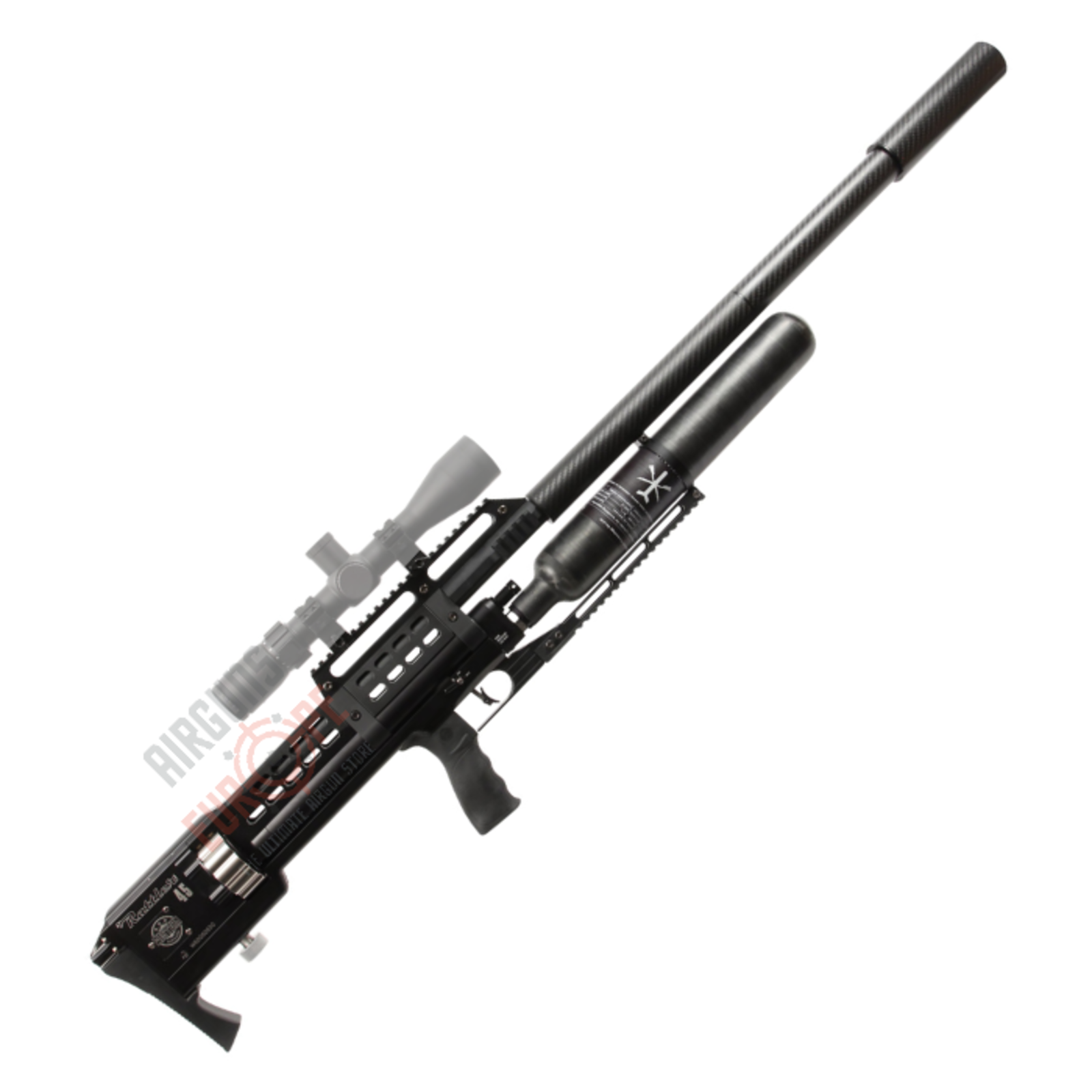
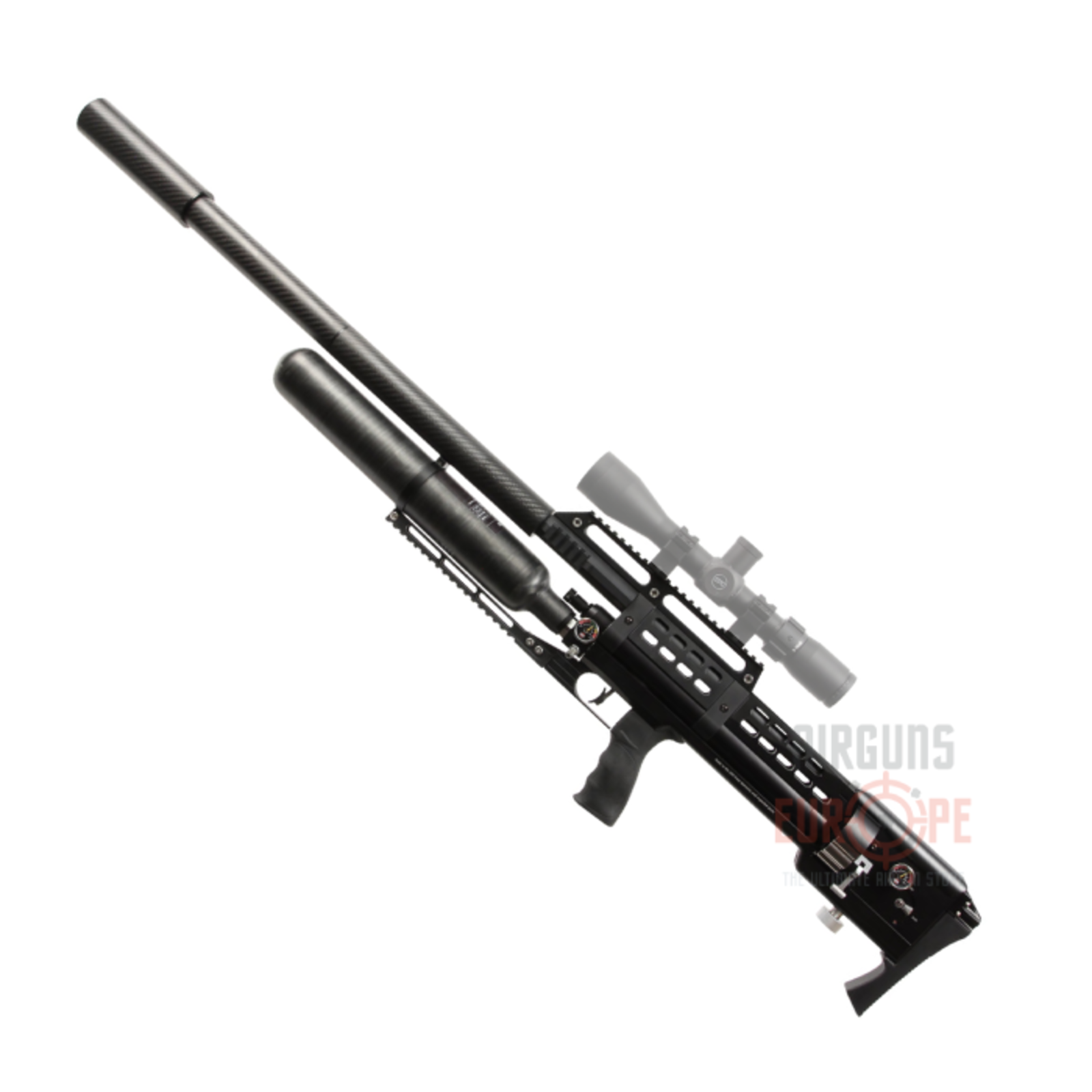
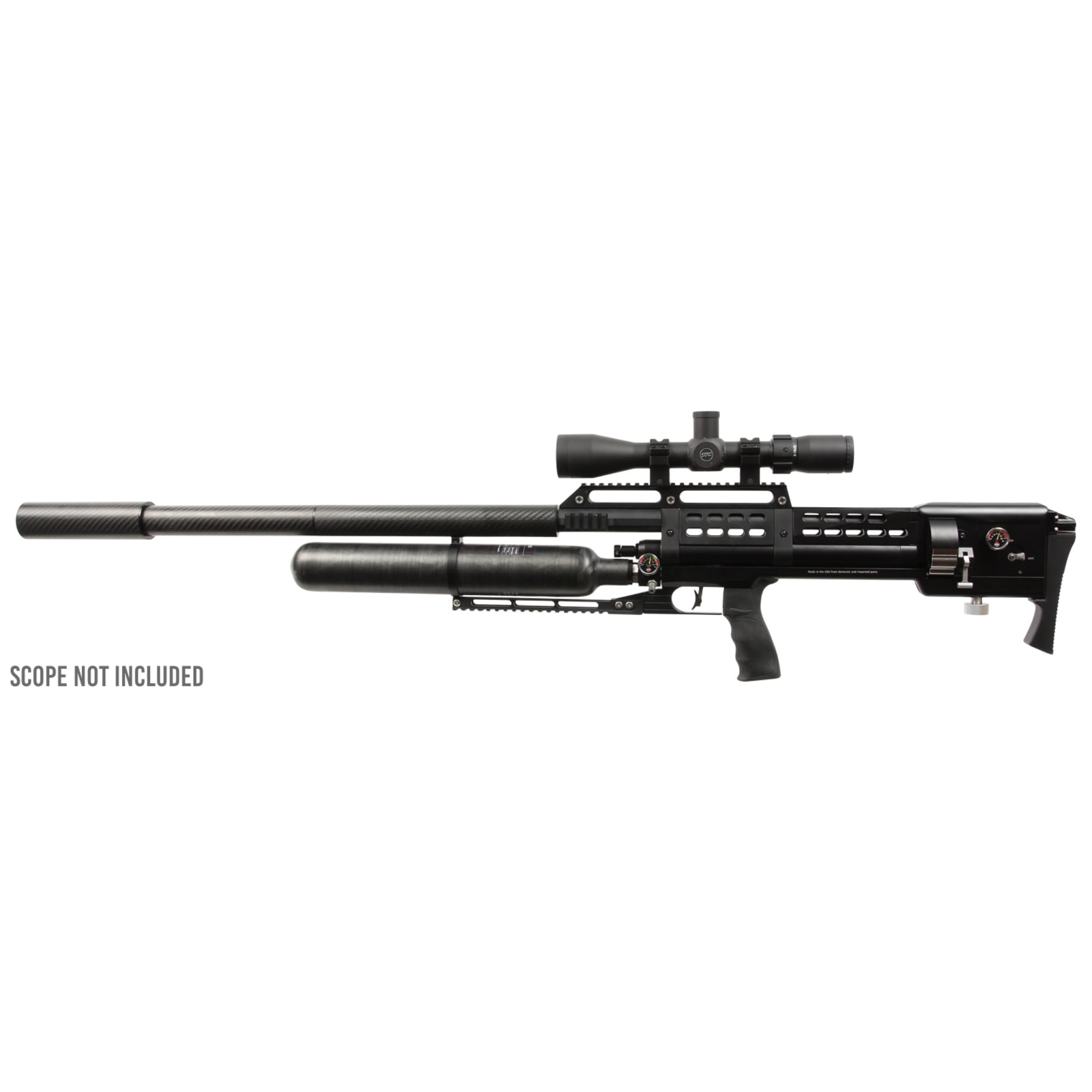
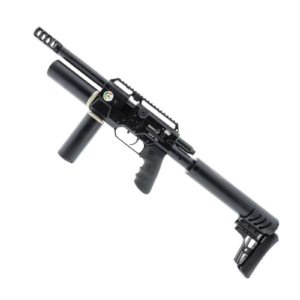
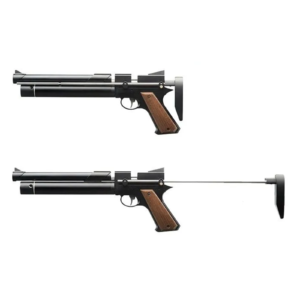
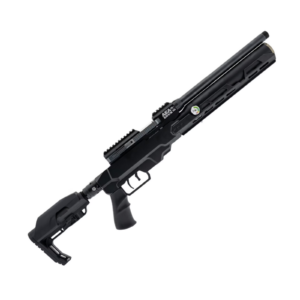
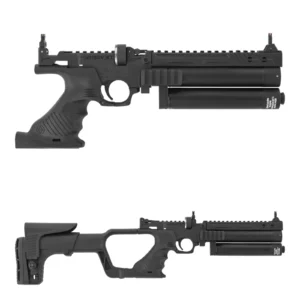
Reviews
There are no reviews yet.